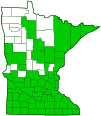cup plant
(Silphium perfoliatum var. perfoliatum)
Conservation • Wetland • Description • Habitat • Ecology • Use • Distribution • Taxonomy
Description |
||
Cup plant is an erect, perennial forb that rises on usually a cluster of several stems, sometimes a single stem, from a central taproot; numerous shallow, spreading rhizomes; and fibrous roots. It can be 2½′ to 10′ in height, but is usually no more than 8′ tall. It sometimes forms colonies. The stems are erect, stout, square in cross section, unbranched below the inflorescence, and usually hairless. They are often shiny with a varnished appearance. They are occasionally slightly covered with a whitish, waxy coating (glaucous). They are green at first, often becoming reddish as the season progresses. Basal leaves are egg-shaped to triangular egg-shaped or lance-shaped, unlobed, long-stalked, 4″ to 12″ long, and up to 9½″ wide. They are rough to the touch and thick but not leathery or only slightly leathery. The leaf stalk is often expanded at the base into an ear-like lobe that wraps around the stem. The leaf blade is tapered or angled at the base and tapers to a sharp point at the tip. The margins are coarsely toothed. Stem leaves are opposite, 1¼″ to 13¾″ long, and ¼″ to 9½″ wide. The bases of opposite leaves are fused together at the base (perfoliate) to form a cup that holds water. Stem leaves are otherwise similar to basal leaves. They become progressively smaller as they ascend the stem from near the midpoint. Basal and lower stem leaves are withered or absent at flowering time. The inflorescence is a loose, open, branched cluster (panicle) of several flower heads at the end of the stem. The flower heads may be long- or short-stalked or unstalked. The flower heads are 1¾″ to 2¾″ in diameter. The whorl of modified leaves (bracts) at the base of the flower head (involucre) is bell-shaped to hemispheric and ½″ to 1″ long. It is composed of 25 to 37 bracts (phyllaries) in 2 or 3 overlapping series. The phyllaries are elliptic to broadly egg-shaped, pointed at the tip, usually hairless, and ½″ to 1 1 ⁄16″ long. The outer series is tightly appressed. There are 17 to 35 ray florets and 85 to 150 or more disk florets. The ray florets are yellow and ⅝″ to 1 9 ⁄16″ long. The disk florets are yellow. The fruit is a dry, one-seeded seed capsule (cypsela). The cypsela is black to brown, egg-shaped, flattened, 5 ⁄16″ to ½″ long, and 3 ⁄16″ to ⅜″ wide. It is broadly winged and has a deep notch at the tip. There is no tuft of hairs attached to the end. |
||
Height |
||
30″ to 120″ |
||
Flower Color |
||
Yellow ray florets, yellow disk florets |
||
Similar Species |
||
|
||
Habitat |
||
Wet to moderate moisture. Prairies, meadows, fens, woodland edges, streambanks, and ditches. Full or partial sun. |
||
Ecology |
||
Flowering |
||
July to September |
||
Pests and Diseases |
||
|
||
Use |
||
|
||
Distribution |
||||
|
Sources |
|||
| 4/3/2023 | ||||
Nativity |
||||
Native |
||||
Occurrence |
||||
Common |
||||
Taxonomy |
|||
| Kingdom | Plantae (green algae and land plants) | ||
| Subkingdom | Viridiplantae (green plants) | ||
| Infrakingdom | Streptophyta (land plants and green algae) | ||
| Superdivision | Embryophyta (land plants) | ||
| Division | Tracheophyta (vascular plants) | ||
| Subdivision | Spermatophytina (seed plants) | ||
| Class | Magnoliopsida (flowering plants) | ||
| Superorder | Asteranae | ||
Order |
Asterales (sunflowers, bellflowers, fanflowers, and allies) | ||
Family |
Asteraceae (sunflowers, daisies, asters, and allies) | ||
| Subfamily | Asteroideae | ||
| Supertribe | Helianthodae | ||
| Tribe | Heliantheae (sunflowers and allies) | ||
| Subtribe | Engelmanniinae | ||
| Genus | Silphium (rosinweeds) | ||
| Species | Silphium perfoliatum (cup plant) | ||
Subordinate Taxa |
|||
|
|||
Synonyms |
|||
Common Names |
|||
cup plant cup-plant cupleaf cupleaf rosinweed squarestem rosinweed |
|||
Glossary
Bract
Modified leaf at the base of a flower stalk, flower cluster, or inflorescence.
Cypsela
A dry, one-chambered, single-seeded fruit, formed from a single carpel, with the seed attached to the membranous outer layer (wall) only by the seed stalk; the wall, formed from the wall of the inferior ovary and also from other tissues derived from the receptacle or hypanthium, does not split open at maturity, but relies on decay or predation to release the contents.
Glaucous
Pale green or bluish gray due to a whitish, powdery or waxy film, as on a plum or a grape.
Involucre
A whorl of bracts beneath or surrounding a flower, flower head, or flower cluster.
Panicle
A pyramidal inflorescence with a main stem and branches. Flowers on the lower, longer branches mature earlier than those on the shorter, upper ones.
Perfoliate
A leaf having margins that entirely surround the stem, giving the appearance that the stem is growing through the leaf.
Phyllary
An individual bract within the involucre of a plant in the Asteraceae family.
Rhizome
A horizontal, usually underground stem. It serves as a reproductive structure, producing roots below and shoots above at the nodes.
Wing
A thin, flat, membranous, usually transparent appendage on the margin of a structure.
Visitor Photos |
|||||
Share your photo of this plant. |
|||||
| This button not working for you? Simply email us at info@MinnesotaSeasons.com. Attach one or more photos and, if you like, a caption. |
|||||
|
|||||
MinnesotaSeasons.com Photos |
|||||
Plant |
|||||
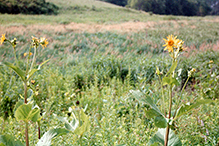 |
|||||
Inflorescence |
|||||
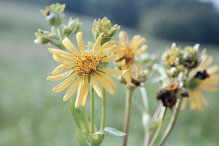 |
|||||
Flower Head |
|||||
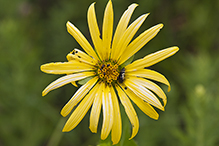 |
|||||
Leaves |
|||||
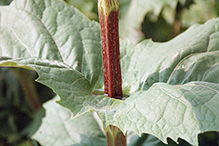 |
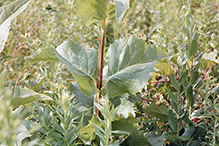 |
||||
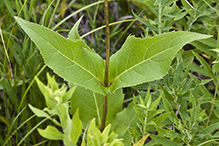 |
|||||
Stem |
|||||
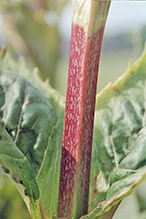 |
|||||
Early Spring |
|||||
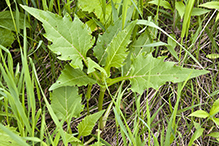 |
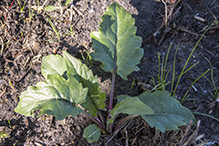 |
||||

Slideshows |
||

Visitor Videos |
|||
Share your video of this plant. |
|||
| This button not working for you? Simply email us at info@MinnesotaSeasons.com. Attach a video, a YouTube link, or a cloud storage link. |
|||
Other Videos |
|||
| Cup Plant - Silphium perfoliatum at Ion Exchange Ionxchange |
|||
About
Uploaded on Aug 1, 2011 Earthyman films Cup Plant (Silphium perfoliatum) growing at Ion Exchange in NE iowa. http://www.ionxchange.com Bright yellow flowers bloom in July/August. |
|||
| Minnesota Native Plant - Cup Plant (Silphium Perfoliatum) MNNativePlants |
|||
About
Published on Aug 8, 2013 Todays plant is the Cup Plant (Silphium Perfoliatum var. Perfoliatum). A beautiful plant to have near a pond! |
|||

Visitor Sightings |
|||||
Report a sighting of this plant. |
|||||
| This button not working for you? Simply email us at info@MinnesotaSeasons.com. Be sure to include a location. |
|||||
|
|||||
MinnesotaSeasons.com Sightings |
|||||
Carpenter St. Croix Valley Nature Center Carver Highlands WMA, South Unit Forestville/Mystery Cave State Park John Peter Hoffman Spring Brook Valley WMA Minnesota Valley NWR, Louisville Swamp Unit Minnesota Valley NWR, Wilkie Unit Nerstrand Big Woods State Park Northern Tallgrass Prairie NWR, Touch the Sky Prairie Unit Verlyn Marth Memorial Prairie SNA |
|||||

|
Created: Last Updated: © MinnesotaSeasons.com. All rights reserved. |
